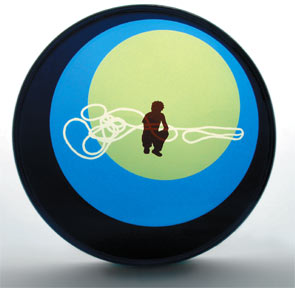Edith Beaucage
dal 23/9/2005 al 8/10/2005
Segnalato da
23/9/2005
Edith Beaucage
Andrew Shire Gallery, Los Angeles
Up Life: A Series Under Glass. The artist's formal vocabulary consists of geometric shapes, often rounded, set against one another in dynamic yet eccentric, even subtly comical, contraposition. But now she has introduced an element that could be considered anathematic to her non-objective world: the human figure.

Up Life: A Series Under Glass
Edith Beaucage has spent the last several years refining her art into an
eccentric but lucidly reasoned and carefully controlled manifestation of
pure form. Beaucage's formal vocabulary consists of geometric shapes, often
rounded, set against one another in dynamic yet eccentric, even subtly
comical, contraposition. But now, in a major shift, Beaucage has introduced
an element that could be considered anathematic to her non-objective world:
the human figure. In one sense, this is a reintroduction; Beaucage began as
a figure painter. But she has not ³returned to the figure² as such. On the
contrary, the figure itself now, well, figures as yet another element  the
focal element, to be sure, but a single, even lone element nonetheless  in
compositions that otherwise remain entirely abstract. Indeed, Beaucage¹s
expanded vocabulary of shapes in these new works heightens their elegance
and mystery  and the presence of human ciphers only makes matters odder.
If we go back to the origins of abstract art, we see that, by and large,
abstraction's progenitors were not seeking simply to make art out of nothing
but (more or less) elementary shapes. The invested great meaning in their
compositions; whether that meaning was a matter of proprioperception (as in
synesthetic response to, for instance, musical stimulation); quasi-religious
transcendence; basic symbolic  heraldic and/or metaphysical  alignments
(that would effectively establish a syntax among formal vocabularies); or
any combination thereof. It has been only in the last few decades that
abstract artists have been content to replace what the abstract
expressionists called the 'subjects of the artist' with the thoroughgoing
self-referentiality of (as Frank Stella put it), 'what you see is what you
see' Â inferring that what you see means nothing more than itself.
By situating the figure, that most empathy-inducing of images, at the heart
of her abstract formulations  and especially by doing so at various layers
of sandwiched glass  Beaucage returns our understanding of abstraction to
an interpretive, subjective, and empathically responsive discourse. The
shapes we see at play now don't just play with one another; they play with Â
around, on, out of  the homo sapiens in their midst. Yes, it is about you;
the universe may not be anthrocentric, but art is. The proper measure of
mankind, after all, is still man, and art is, if anything, as full a measure
of man, and woman, as humankind could devise.
Beaucage's is not a romantic art by any means. Her figures do not grow in
experience, they are not doing anything momentous, nor are they otherwise
engaged in any teleological process. Rather, they exist in an enduring
present, a condition of engagement that Beaucage has made permanent and,
thus by inference, eternal. Beaucage has quite consciously invested her
signs and designs with certain spiritual significance, at least some of
which she overtly intends for her new artworks to convey. (She writes, for
instance, of describing man's 'inner energy' in one piece, his 'creative
thought' in another, and has realized at least two 'self-portraits' in which
she places herself amidst a supportive and reinvigorating choreography of
forms.) But we don't require the artist's explanation, iconographic guide,
or other exterior revelation to grasp at least the generalized presence here
of extra-retinal significance. No matter where they position themselves or
their respective glass supports, the elements, human or geometric, co-exist
in coherent yet volatile counterpoint.
It should be emphasized that Beaucage has not inserted the figure into her
abstractions in order to ³humanize² them, but simply to ground them. The
works under glass could be considered ³applications² of the theoretical
circumstances proposed by her figure-less paintings. They perform a didactic
role, to be sure, cluing those still resistant to abstract art  and those
who regard abstraction as mere eye candy  to its substance. The figures
demonstate the concretion of what can otherwise be construed, rightly or
wrongly, as ineffable. To Beaucage, as to her abstract forebears and many of
her peers, it is precisely those ineffable qualities that she seeks to
invoke. Does she invoke them any more effectively by introducing figural
ciphers? Some would concur, even insisting that this remain her approach
from here on. Others would demur, even hoping that she abandon this series
and return the visual and conceptual ³purity² of her paintings. Beaucage is
not likely to defer to either preference; her work is first and foremost
about those abstract shapes, their meanings, and their potential for
meaning. She has accepted the fact that such meaning, and such potential,
can come across in more ways than one. In Edith Beaucage¹s universe, the
ineffable can be the measure of man.
Opening reception: Saturday, September 24, 6:30-8:30pm
Edith will present her Color, Form and Light performance at 7:30pm,
accompanied by Dr. Phoenix Camden performing on High Frequency Crystal Bowls.
Image: Edith Beaucage, 'Thought', 2005, lamintated film in glass disks, 5' x 5'.
Andrew Shire Gallery
3850 Wilshire Blvd #107 - Los Angeles
Hours, Tuesday  Saturday, 11am - 5pm



